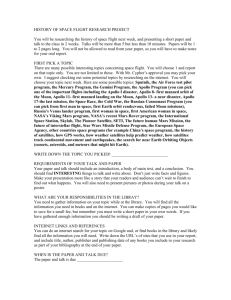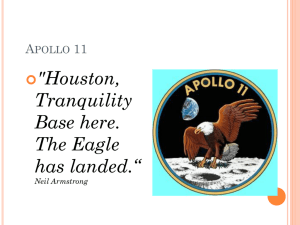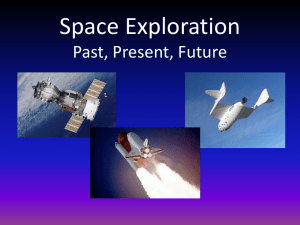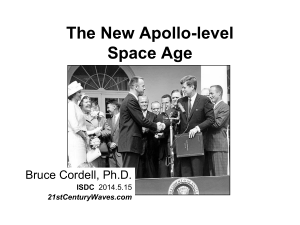Space Race 1960s: The Explorer - ESL 100
advertisement
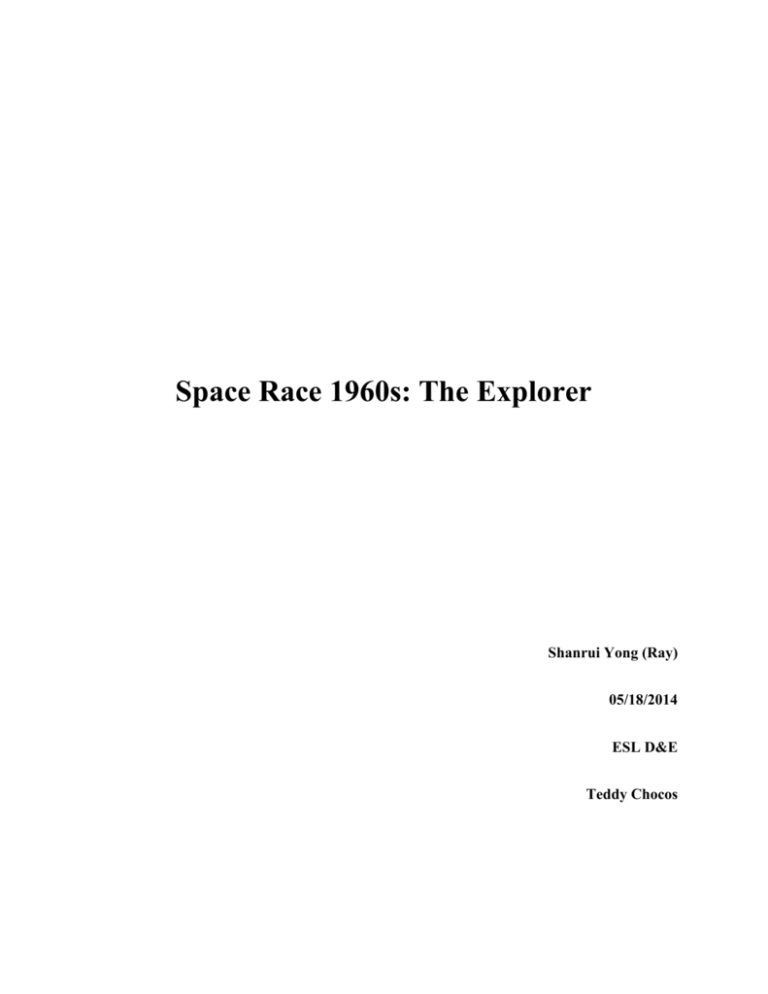
Space Race 1960s: The Explorer Shanrui Yong (Ray) 05/18/2014 ESL D&E Teddy Chocos “10 …3, 2, 1, 0 All engines running, liftoff on Apollo 11.” On July 16th 1969, Apollo 11 lifted off from Kennedy Space Center in Florida. After four-day space journey with 238,900 miles from earth, Neil Armstrong became the first astronaut who arrived on the moon and represented all mankind to leave his first footprint on the lunar surface. This great event will always be remained in Americans’ memory. More importantly, successfully landing on the moon was one of the best milestones in human’s technological progress. However, the United States was the laggard at the beginning of the competition with the Soviet Union. During the International Geophysical Year (1957-1958), both nations made the plan to launch their satellites into space. The first satellite Sputnik I was successfully set by the Soviet Union on October 4, 1957. At that time, the United States was still working on a launch vehicle. The success of Sputnik I acted as a wake-up call to make the Americans realize that they were lagging far behind their competitor, the Soviet Union, in the development of space technology. Furthermore, Americans feared that the Soviet Union would have the ability to launch the missiles, which could carry the nuclear weapons, and treat the United States as one of its targets. As a result, President Eisenhower established a new department called the National Aeronautics and Space Administration (NASA) in 1958 to oversee the space program and to make sure that the United States could catch up to the Soviet Union. From this establishment, the space race had officially begun. During the period of competition with the Soviet Union, the United States gradually established its global power through each progressive step of the exploration of space. Before the Apollo mission, moonwalk was a daydream that only existed in movies and science fictions. However, Americans successfully made this dream to be true. In 1961, President John F. Kennedy gave a speech in the public. He announced, “I believe that this nation should commit itself to achieving the goal, before this decade is out, of landing a man on the moon and returning him safely to earth”. Then he claimed, “We choose to go to the moon in this decade and do the other things, not because they are easy, but because they are hard, because that goal will serve to organize and measure the best of our energies and skills…” By the president’s mobilization, Americans worked together to achieve their common goal which other nations seemed impossible to obtain. In the chapter “The Frontier Heritage” of the book “American Ways: An Introduction to American Culture”, Maryanne Kearny Datesman points out, “Americans like to believe that a difficult problem can be solved immediately- an impossible one may take a little longer. They take pride in meeting challenges and overcoming difficult obstacles.” (p. 86) This lifestyle is so productive that brings wealth and prosperity to this nation. In the space race, Americans showed their attitude and efforts, that “nothing is impossible for Americans”. Only eight years after the President Kennedy’s speech, like his promise, Americans proved once more that they were the best when Neil Armstrong took the first moonwalk in 1969. From imagination to reality, Apollo 11 would restore the nation’s self-confidence and rebuild its status to be the world leader. When Neil Armstrong went out the lunar lander and walked on the moon surface at the first time, millions of people on the earth heard his famous quote: “That’s one small step for a man, one giant leap for mankind.” He did not only represent to all American people, but also represent to all people in the world that this event of space exploration would become a part of human’s history. Meanwhile, Apollo mission reflected the great optimism of 1960s American liberalism regarding the feasibility of big technological projects. Armstrong realized the ideal of the independent American pioneers in a more technological time. In the fourth chapter of article “Live from the Moon: The societal impact of Apollo”, Andrew Chaikin states, “By winning the space race with the Soviet Union, Apollo had given a boost to the nation’s prestige in the world and, for many Americans, a heightened a sense of national pride.” (p. 66) Americans were proud that they were a part of their nation when the American flag was set on the moon. Also by winning the space race, the United States exhibited the super power of all Americans to the globe and became the leader of the world. Considering the original designing of the Stars and Stripes, each of the states was represented on the American flag by a star, as there were no difficulties that Americans couldn’t overcome when the United States became the one. The space technology development also directly benefitted people’s daily life. Nowadays, people could easily experience the profits which were derived from the space program. For example, in each day, while using the mobile devices, such as GPS and cellphones which transfer the information via satellites, people successfully get convenience from them. When people decide to bring umbrellas after they get the weather forecast updated on their phones or televisions, they can obtain accurate prediction. Many different fields benefit from space technology development as well and most of them can support people’s life better. In the field of health and medicine, people can see the effectiveness that a life can be saved when a heart defibrillator restores the proper rhythm of a patient’s heart. Also the weather satellites protect people’s lives when they receive the warning about the coming typhoon. All in one word, the space technology has become a significant part of people’s daily life. Through the space technology development, human beings take science and exploration into a new millennium. At the beginning of the space technology development, Americans were so helpless that they had to rely on themselves, but they successfully used their invention and creation to make many history events. Like the early American pioneers used the inventive skills to live in the western land, they did not only provide most of the essentials for their daily life, but also faced new problems and situations which required new solutions. In the book “American Ways: An Introduction to American Culture”, Datesman points out that “The need for selfreliance on the frontier encouraged a spirit of inventiveness.” (p. 85) The early frontiers didn’t rely on others’ help too much, but believed that they could solve the problems with their own hands and brains. Through the history, the frontier’s innovations and creations are the most important factors which helped the nation keep strong and wealthy. Americans used their creativity to start a new chapter of the history of space exploration. The event that Soviet Soyuz craft docked with the American Apollo 18 represented the end of the space race. However, the race made the two nations closely connect; they seemed more to be cooperators than competitors. In fact, the cooperation continues to exist between the Russian and U.S. space programs in building and servicing the International Space Station (ISS). After the U.S. Space Shuttle move to retirement by 2011, the Russian and Chinese Space program have the only operation manned space programs, and personnel adjust at ISS would rely on Russian transport. Therefore, to explore the solar system in the future need each nation make their own contribution, which required they work in cooperation with a due division of labor. In the fourth chapter of the article “Live From The Moon: The societal impact of Apollo”, Andrew Chaikin states, “No matter how far humans are able to go in their quest to explore the universe, the Apollo missions will stand as the opening chapter.” While the NASA already set the goal for exploring the Mars, and human beings will continue to explore further. The Apollo program’s significance is not only to send a man on the moon, but also represent that humans have the ability to accomplish seemingly impossible things when they work together. Americans never stop to explore the world. The United States set the goal that Americans will be back to the moon before 2020. It is not only for another history event, but also for humans to be on the way to conquer space. Datesman agrees when he includes the quote from Frederick Jackson Turner, an American historian in the early 20th century, “This ever-retreating frontier of free land is the key to American development.” (p. 77) Americans inherit the can-do spirit from the frontier, which is the most important factor that makes the progress for exploring the free land. Americans never stop to explore, since the last western lands were settled in 1890, they wait for a long time to explore the new land. Now, exploring moon is only a beginning. On the whole, Americans make the greatest contribution for mankind space technology development through the space race. The desire of freedom and the need to explore free land will drive Americans to make another history event in the near future. Work Cited Datesman, Maryanne Kearny. American Ways: An Introduction to American Culture / Maryanne Kearny Datesman, JoAnn Crandall, Edward N. Kearny.—Fourth edition. Andrew, Chaikin. "Live from the Moon: The Societal Impact of Apollo." Societal Impact of Spaceflight: 53-66. Werth, Karsten. "A Surrogate for War—The U.S. Space Program in the 1960s." Amerikastudien / American Studies 49.4 (2004): 563-87. JSTOR. Web. 18 May 2014. <http://www.jstor.org/stable/10.2307/41158096?ref=searchgateway:fc476425b70ad68b4577ef16c13f2fd1>.
